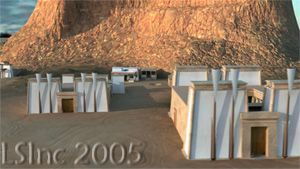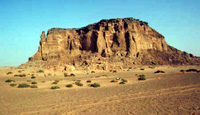| About
1450
BCE,
the Egyptian pharaoh Thutmose III extended his conquests to Gebel Barkal
and established it as the southern border of his empire. The city
he founded there was called Napata. The Egyptians remained only about 300
years. Later Napata became the seat of royal authority of an independent
Nubian kingdom called Kush, and from about 720 to 660 BCE
its kings conquered and ruled Egypt as the 25th Dynasty. Napata was
the political capital of Upper Egypt (northward to Memphis) during the
late-8th-century reign of Piyankhy (or Piye). After the Kushites
were driven out of Egypt, Napata continued as an important royal residence
and religious center until about 350 BCE, when the
kingdom finally collapsed.
The
extensive
remains at Gebel Barkal (encompassing at least 13 temples and 3 palaces)
were first observed and described by European explorers in the 1820s, but
it was not until 1916 that the first major excavations were undertaken,
by George A. Reisner and the joint Harvard University/ Museum of Fine Arts,
Boston, Expedition. Reisner cleared nine buildings at the site and
assigned them each a 100-number, prefaced by the letter B (for Barkal).
From the 1970s to the present, excavations have continued by a team from
the University of Rome, under the direction of Sergio Donadoni, which was
joined in the 1980s by another team from the Boston museum, under the direction
of Timothy Kendall. |

Overview of the temple complex, from B1200 (at the right) to B700 (in the rear), and B300 (at the far left).
(click on the image to enlarge)
|
LEARNING
SITES is working with
Timothy Kendall to reconstruct the site digitally, one temple at a time.
The resulting 3D models, high-resolution animations, and virtual worlds
will be first used as research tools for better understanding the function
of the site and its many buildings. Subsequently, the material will
be made available for museum display kiosks and educational materials.
In 2006, Learning Sites' flyover of Gebel Barkal was featured in a program on ancient Sudan for Japanese TV produced by Nexent.
|
